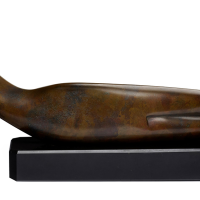18. ALEXANDER ARCHIPENKO

Alexander Archipenko belonged to the early twentieth century wave of Eastern European artists who moved to the West in search of freedom, economic stability, and artistic success. Archipenko quickly followed in the footsteps of other Eastern expatriate artists, taking up residence in La Ruche, Paris in 1908. There he became a member of the prestigious Section dOr group, putting him in the company of Marcel Duchamp (1887-1968), Pablo Picasso (1881-1973), and Guillaume Apollinaire (1881-1918). By 1910 Archipenko was exhibiting with the Cubists at the Salon des Indpendants, and from 1911 to 1913 his sculpture was shown at the Salon dAutomne.
Leaving Paris for Nice, following the outbreak of the First World War in 1914, Archipenko began producing sculpto-peintures, a radical form of sculpture inspired by two-dimensional art forms. Archipenko was praised by critics for reinterpreting sculpture in low relief, establishing his international reputation. So much so that when he arrived in New York in November 1923, The World reported that Archipenko was considered by many persons the greatest living sculptor.1
Archipenko dematerialised his sculpture in the round by introducing negative spaces to denote parts of the body. For subject matter, he remained faithful to the female form, a central motif in the artists work. His figures of women take on the presence of real people, not in their surface naturalism, but in their essence, which he viewed as a fusion of harmony, aesthetic beauty, and spirit.2
A variety of cultural sources lie behind Archipenkos work. He remained indebted to the spiritual values and visual effects found Byzantine culture and had a strong affinity for ancient Egyptian, Gothic, and primitive art. Consequently, Archipenkos female figures look like fragmentary ancient statues, headless and with missing limbs and forms that evoke rather than describe.
Archipenko was at his best when endowing sculptural form with real presence. Whilst the search for a timeless representation of women brought the artist close to abstraction, he avoided complete fragmentation, and stressed instead the fluidity of the forms. Archipenko gave his female subject a clear and organic structure by assigning equal significance to every part of her body.
Lying Horizontal Figure 1957 beautifully encapsulates this totality. Comparable to Archipenkos celebrated Torso in Space 1936 (Whitney Museum of American Art, New York), this graceful, fluid figure floats in space, attached to infinity.
Footnotes:
1. Quoted from a newspaper clipping illustrated in Karsham, D., Archipenko: International Visionary, Smithsonian Institution Press, Washington D.C., 1969, p.70
2. Archipenko, A., Archipenko: Fifty Creative Years 1908-58, Tekhne, New York, 1960, p.35